BSBCOM603 - Compliance Management System for SC Blue Ribbon
VerifiedAdded on 2023/05/28
|9
|2233
|231
Report
AI Summary
This report outlines a comprehensive compliance management system for SC Blue Ribbon Charity Care, a not-for-profit charity. It details the research plan, including tasks and methodology involving mixed methods for data collection and analysis. The report identifies internal, external, and industry-specific compliance requirements, such as safety and health management, sexual harassment policies, equal employment opportunity, privacy policies, and accounts receivable policies. It further analyzes the effects of compliance on various areas of the organization, the risks of non-compliance, penalties for breaches, and strategies for risk minimization. The document also compares different compliance system components—board oversight, compliance programs, and compliance audits—in terms of cost, effectiveness, efficiency, feasibility, and match to organizational culture, ultimately recommending a coordinated approach for an effective compliance system. This resource is helpful for students studying compliance and risk management.
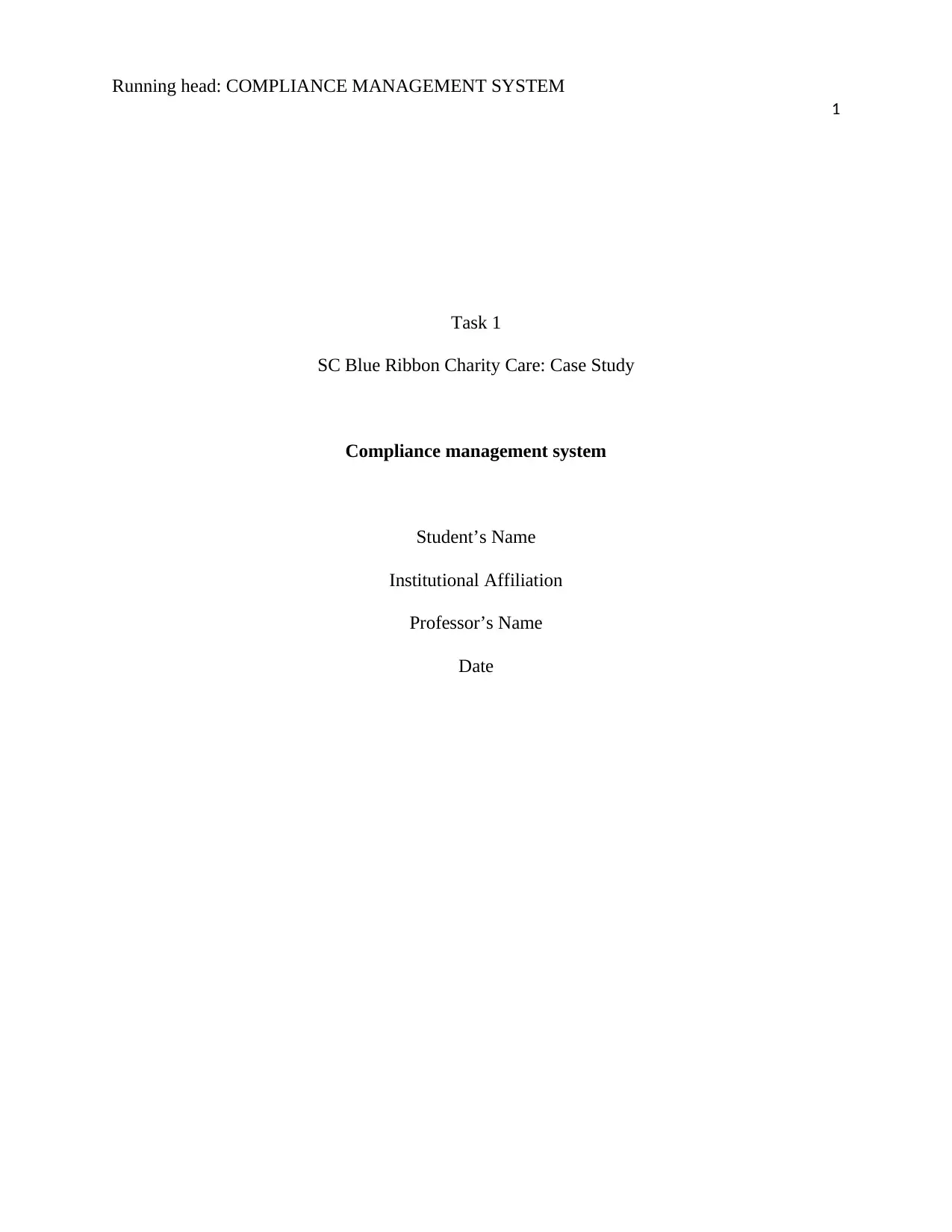
Running head: COMPLIANCE MANAGEMENT SYSTEM
1
Task 1
SC Blue Ribbon Charity Care: Case Study
Compliance management system
Student’s Name
Institutional Affiliation
Professor’s Name
Date
1
Task 1
SC Blue Ribbon Charity Care: Case Study
Compliance management system
Student’s Name
Institutional Affiliation
Professor’s Name
Date
Paraphrase This Document
Need a fresh take? Get an instant paraphrase of this document with our AI Paraphraser
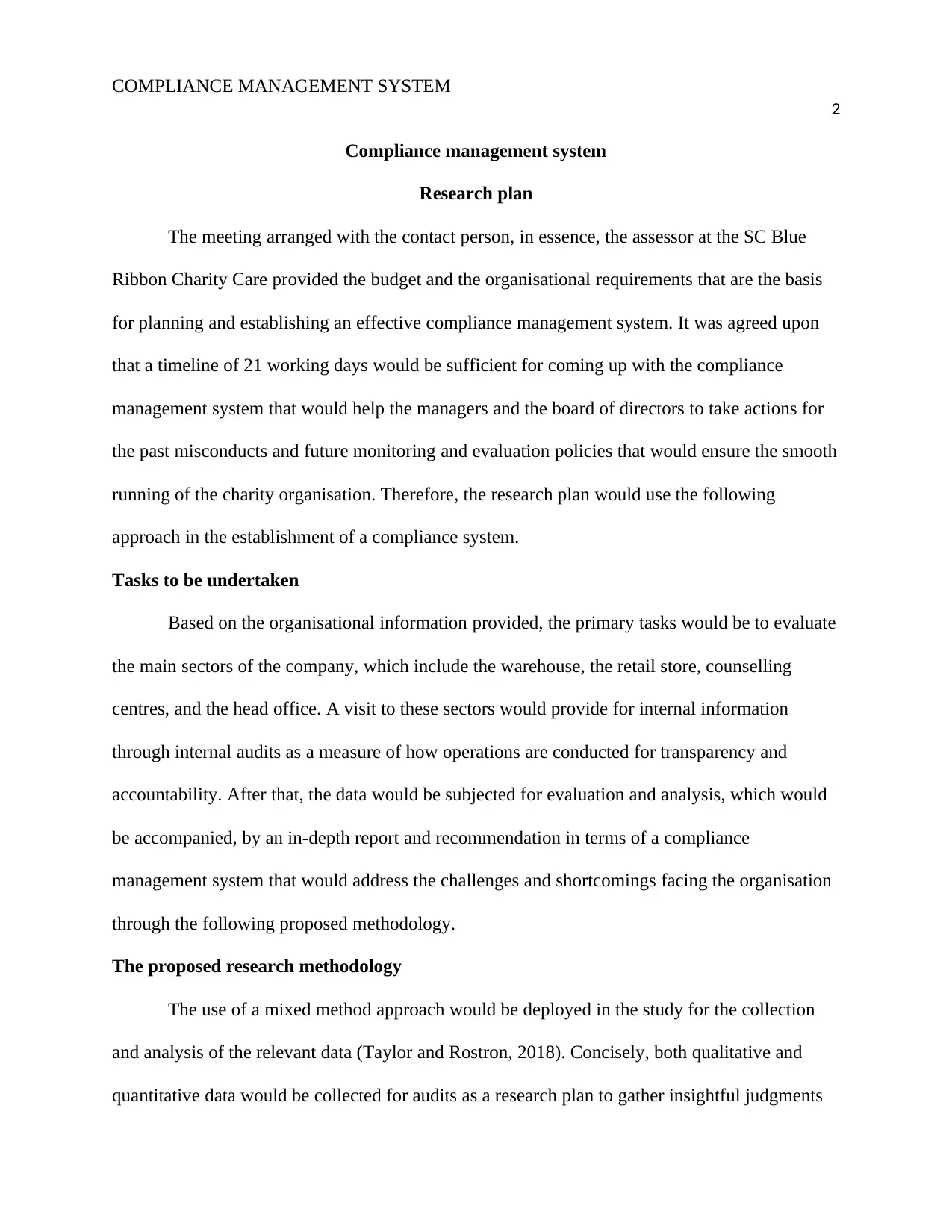
COMPLIANCE MANAGEMENT SYSTEM
2
Compliance management system
Research plan
The meeting arranged with the contact person, in essence, the assessor at the SC Blue
Ribbon Charity Care provided the budget and the organisational requirements that are the basis
for planning and establishing an effective compliance management system. It was agreed upon
that a timeline of 21 working days would be sufficient for coming up with the compliance
management system that would help the managers and the board of directors to take actions for
the past misconducts and future monitoring and evaluation policies that would ensure the smooth
running of the charity organisation. Therefore, the research plan would use the following
approach in the establishment of a compliance system.
Tasks to be undertaken
Based on the organisational information provided, the primary tasks would be to evaluate
the main sectors of the company, which include the warehouse, the retail store, counselling
centres, and the head office. A visit to these sectors would provide for internal information
through internal audits as a measure of how operations are conducted for transparency and
accountability. After that, the data would be subjected for evaluation and analysis, which would
be accompanied, by an in-depth report and recommendation in terms of a compliance
management system that would address the challenges and shortcomings facing the organisation
through the following proposed methodology.
The proposed research methodology
The use of a mixed method approach would be deployed in the study for the collection
and analysis of the relevant data (Taylor and Rostron, 2018). Concisely, both qualitative and
quantitative data would be collected for audits as a research plan to gather insightful judgments
2
Compliance management system
Research plan
The meeting arranged with the contact person, in essence, the assessor at the SC Blue
Ribbon Charity Care provided the budget and the organisational requirements that are the basis
for planning and establishing an effective compliance management system. It was agreed upon
that a timeline of 21 working days would be sufficient for coming up with the compliance
management system that would help the managers and the board of directors to take actions for
the past misconducts and future monitoring and evaluation policies that would ensure the smooth
running of the charity organisation. Therefore, the research plan would use the following
approach in the establishment of a compliance system.
Tasks to be undertaken
Based on the organisational information provided, the primary tasks would be to evaluate
the main sectors of the company, which include the warehouse, the retail store, counselling
centres, and the head office. A visit to these sectors would provide for internal information
through internal audits as a measure of how operations are conducted for transparency and
accountability. After that, the data would be subjected for evaluation and analysis, which would
be accompanied, by an in-depth report and recommendation in terms of a compliance
management system that would address the challenges and shortcomings facing the organisation
through the following proposed methodology.
The proposed research methodology
The use of a mixed method approach would be deployed in the study for the collection
and analysis of the relevant data (Taylor and Rostron, 2018). Concisely, both qualitative and
quantitative data would be collected for audits as a research plan to gather insightful judgments
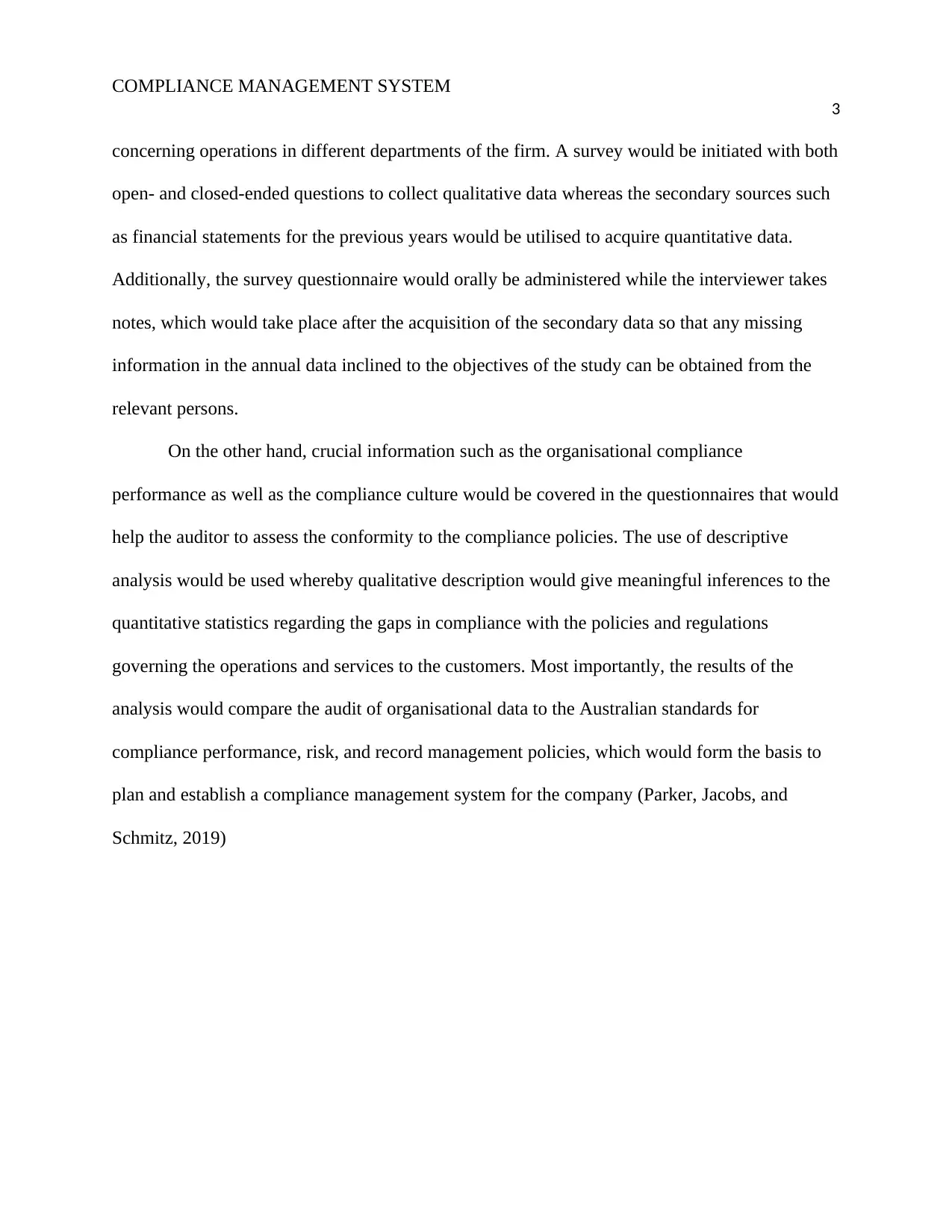
COMPLIANCE MANAGEMENT SYSTEM
3
concerning operations in different departments of the firm. A survey would be initiated with both
open- and closed-ended questions to collect qualitative data whereas the secondary sources such
as financial statements for the previous years would be utilised to acquire quantitative data.
Additionally, the survey questionnaire would orally be administered while the interviewer takes
notes, which would take place after the acquisition of the secondary data so that any missing
information in the annual data inclined to the objectives of the study can be obtained from the
relevant persons.
On the other hand, crucial information such as the organisational compliance
performance as well as the compliance culture would be covered in the questionnaires that would
help the auditor to assess the conformity to the compliance policies. The use of descriptive
analysis would be used whereby qualitative description would give meaningful inferences to the
quantitative statistics regarding the gaps in compliance with the policies and regulations
governing the operations and services to the customers. Most importantly, the results of the
analysis would compare the audit of organisational data to the Australian standards for
compliance performance, risk, and record management policies, which would form the basis to
plan and establish a compliance management system for the company (Parker, Jacobs, and
Schmitz, 2019)
3
concerning operations in different departments of the firm. A survey would be initiated with both
open- and closed-ended questions to collect qualitative data whereas the secondary sources such
as financial statements for the previous years would be utilised to acquire quantitative data.
Additionally, the survey questionnaire would orally be administered while the interviewer takes
notes, which would take place after the acquisition of the secondary data so that any missing
information in the annual data inclined to the objectives of the study can be obtained from the
relevant persons.
On the other hand, crucial information such as the organisational compliance
performance as well as the compliance culture would be covered in the questionnaires that would
help the auditor to assess the conformity to the compliance policies. The use of descriptive
analysis would be used whereby qualitative description would give meaningful inferences to the
quantitative statistics regarding the gaps in compliance with the policies and regulations
governing the operations and services to the customers. Most importantly, the results of the
analysis would compare the audit of organisational data to the Australian standards for
compliance performance, risk, and record management policies, which would form the basis to
plan and establish a compliance management system for the company (Parker, Jacobs, and
Schmitz, 2019)
⊘ This is a preview!⊘
Do you want full access?
Subscribe today to unlock all pages.

Trusted by 1+ million students worldwide
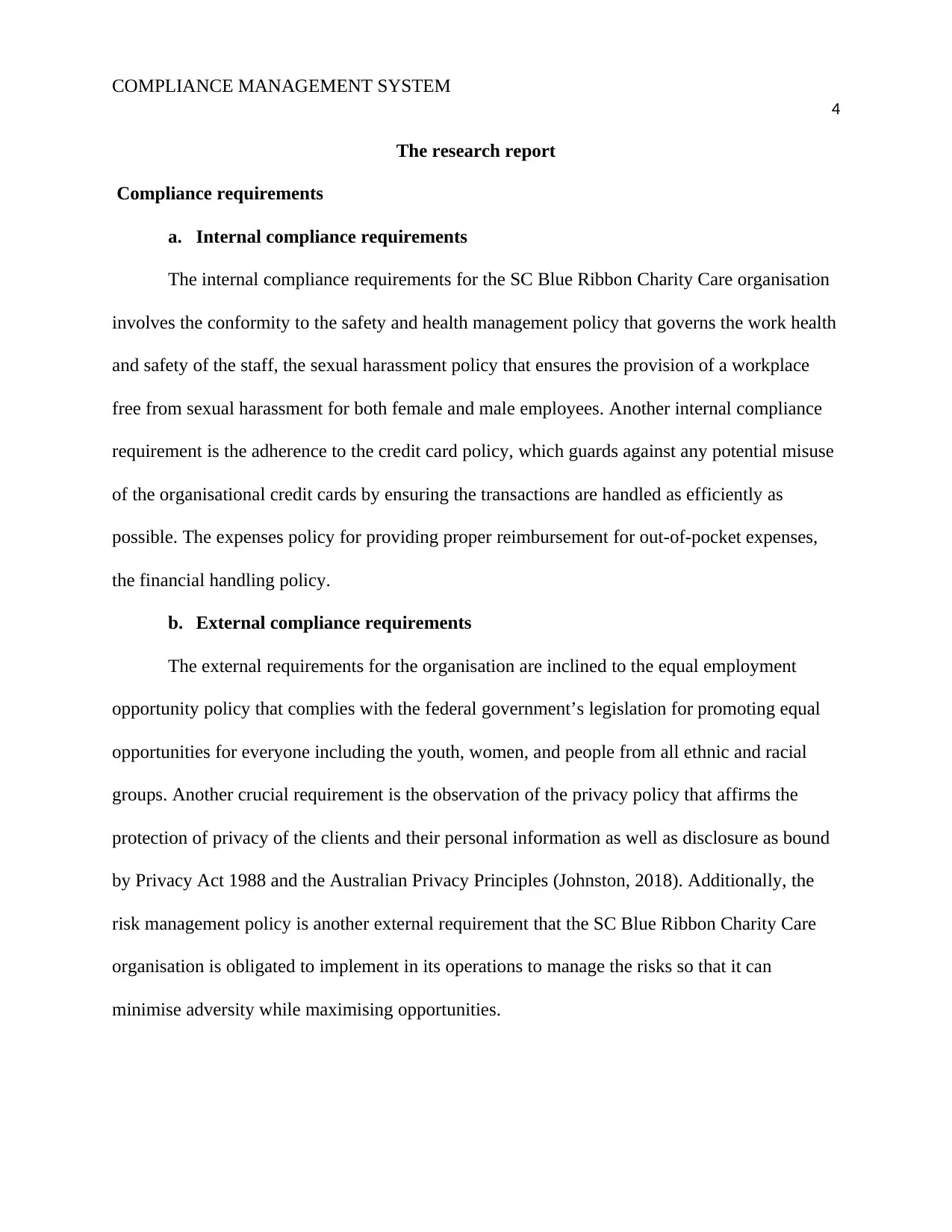
COMPLIANCE MANAGEMENT SYSTEM
4
The research report
Compliance requirements
a. Internal compliance requirements
The internal compliance requirements for the SC Blue Ribbon Charity Care organisation
involves the conformity to the safety and health management policy that governs the work health
and safety of the staff, the sexual harassment policy that ensures the provision of a workplace
free from sexual harassment for both female and male employees. Another internal compliance
requirement is the adherence to the credit card policy, which guards against any potential misuse
of the organisational credit cards by ensuring the transactions are handled as efficiently as
possible. The expenses policy for providing proper reimbursement for out-of-pocket expenses,
the financial handling policy.
b. External compliance requirements
The external requirements for the organisation are inclined to the equal employment
opportunity policy that complies with the federal government’s legislation for promoting equal
opportunities for everyone including the youth, women, and people from all ethnic and racial
groups. Another crucial requirement is the observation of the privacy policy that affirms the
protection of privacy of the clients and their personal information as well as disclosure as bound
by Privacy Act 1988 and the Australian Privacy Principles (Johnston, 2018). Additionally, the
risk management policy is another external requirement that the SC Blue Ribbon Charity Care
organisation is obligated to implement in its operations to manage the risks so that it can
minimise adversity while maximising opportunities.
4
The research report
Compliance requirements
a. Internal compliance requirements
The internal compliance requirements for the SC Blue Ribbon Charity Care organisation
involves the conformity to the safety and health management policy that governs the work health
and safety of the staff, the sexual harassment policy that ensures the provision of a workplace
free from sexual harassment for both female and male employees. Another internal compliance
requirement is the adherence to the credit card policy, which guards against any potential misuse
of the organisational credit cards by ensuring the transactions are handled as efficiently as
possible. The expenses policy for providing proper reimbursement for out-of-pocket expenses,
the financial handling policy.
b. External compliance requirements
The external requirements for the organisation are inclined to the equal employment
opportunity policy that complies with the federal government’s legislation for promoting equal
opportunities for everyone including the youth, women, and people from all ethnic and racial
groups. Another crucial requirement is the observation of the privacy policy that affirms the
protection of privacy of the clients and their personal information as well as disclosure as bound
by Privacy Act 1988 and the Australian Privacy Principles (Johnston, 2018). Additionally, the
risk management policy is another external requirement that the SC Blue Ribbon Charity Care
organisation is obligated to implement in its operations to manage the risks so that it can
minimise adversity while maximising opportunities.
Paraphrase This Document
Need a fresh take? Get an instant paraphrase of this document with our AI Paraphraser
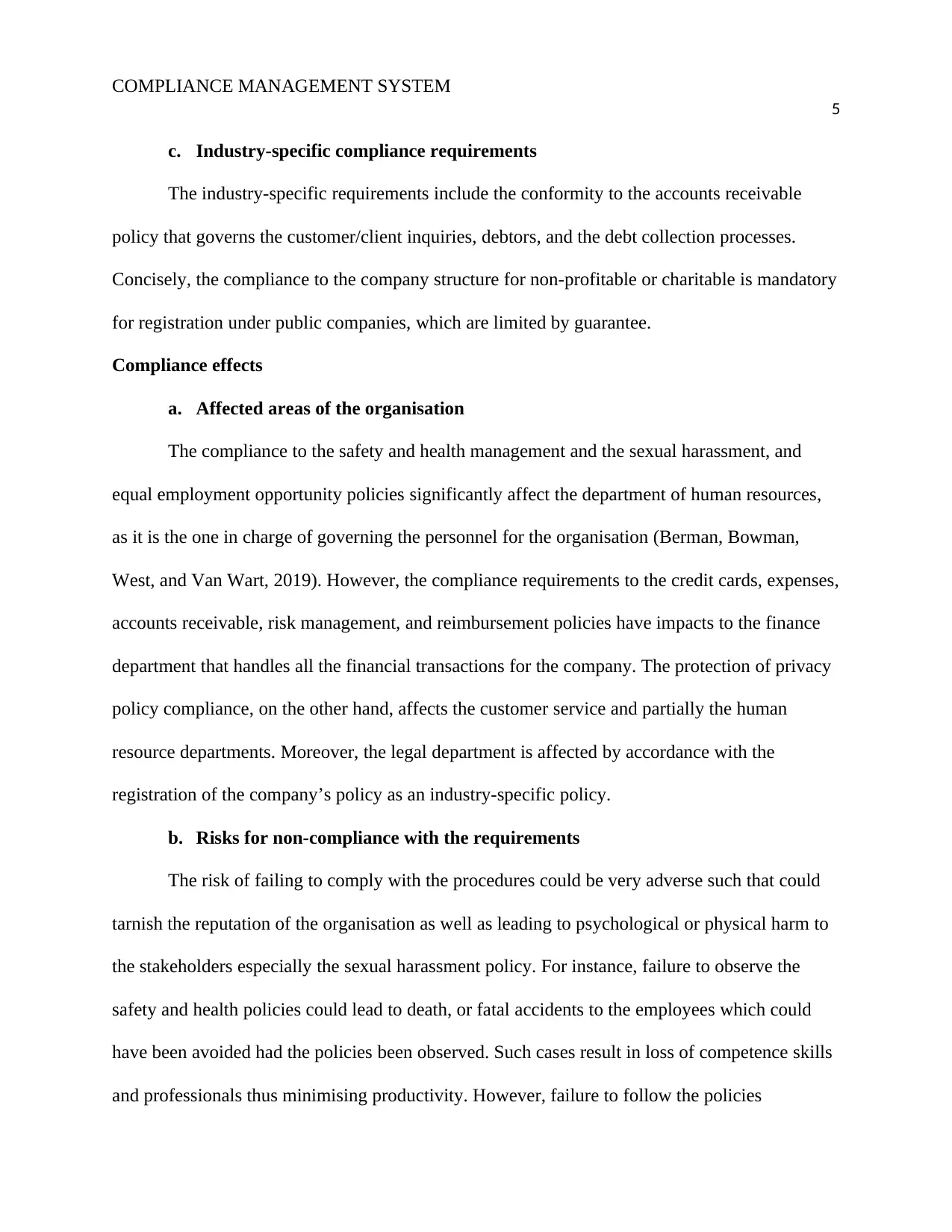
COMPLIANCE MANAGEMENT SYSTEM
5
c. Industry-specific compliance requirements
The industry-specific requirements include the conformity to the accounts receivable
policy that governs the customer/client inquiries, debtors, and the debt collection processes.
Concisely, the compliance to the company structure for non-profitable or charitable is mandatory
for registration under public companies, which are limited by guarantee.
Compliance effects
a. Affected areas of the organisation
The compliance to the safety and health management and the sexual harassment, and
equal employment opportunity policies significantly affect the department of human resources,
as it is the one in charge of governing the personnel for the organisation (Berman, Bowman,
West, and Van Wart, 2019). However, the compliance requirements to the credit cards, expenses,
accounts receivable, risk management, and reimbursement policies have impacts to the finance
department that handles all the financial transactions for the company. The protection of privacy
policy compliance, on the other hand, affects the customer service and partially the human
resource departments. Moreover, the legal department is affected by accordance with the
registration of the company’s policy as an industry-specific policy.
b. Risks for non-compliance with the requirements
The risk of failing to comply with the procedures could be very adverse such that could
tarnish the reputation of the organisation as well as leading to psychological or physical harm to
the stakeholders especially the sexual harassment policy. For instance, failure to observe the
safety and health policies could lead to death, or fatal accidents to the employees which could
have been avoided had the policies been observed. Such cases result in loss of competence skills
and professionals thus minimising productivity. However, failure to follow the policies
5
c. Industry-specific compliance requirements
The industry-specific requirements include the conformity to the accounts receivable
policy that governs the customer/client inquiries, debtors, and the debt collection processes.
Concisely, the compliance to the company structure for non-profitable or charitable is mandatory
for registration under public companies, which are limited by guarantee.
Compliance effects
a. Affected areas of the organisation
The compliance to the safety and health management and the sexual harassment, and
equal employment opportunity policies significantly affect the department of human resources,
as it is the one in charge of governing the personnel for the organisation (Berman, Bowman,
West, and Van Wart, 2019). However, the compliance requirements to the credit cards, expenses,
accounts receivable, risk management, and reimbursement policies have impacts to the finance
department that handles all the financial transactions for the company. The protection of privacy
policy compliance, on the other hand, affects the customer service and partially the human
resource departments. Moreover, the legal department is affected by accordance with the
registration of the company’s policy as an industry-specific policy.
b. Risks for non-compliance with the requirements
The risk of failing to comply with the procedures could be very adverse such that could
tarnish the reputation of the organisation as well as leading to psychological or physical harm to
the stakeholders especially the sexual harassment policy. For instance, failure to observe the
safety and health policies could lead to death, or fatal accidents to the employees which could
have been avoided had the policies been observed. Such cases result in loss of competence skills
and professionals thus minimising productivity. However, failure to follow the policies
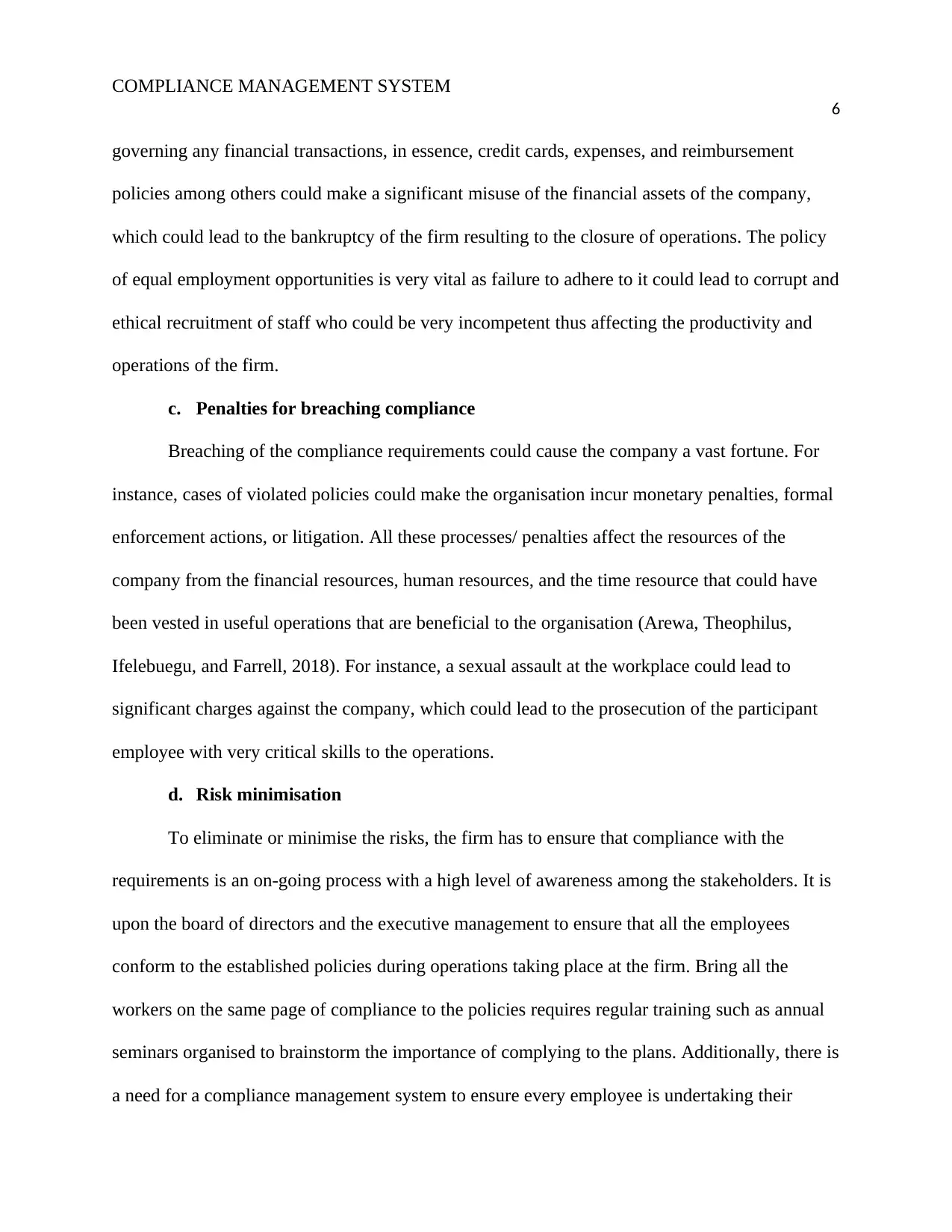
COMPLIANCE MANAGEMENT SYSTEM
6
governing any financial transactions, in essence, credit cards, expenses, and reimbursement
policies among others could make a significant misuse of the financial assets of the company,
which could lead to the bankruptcy of the firm resulting to the closure of operations. The policy
of equal employment opportunities is very vital as failure to adhere to it could lead to corrupt and
ethical recruitment of staff who could be very incompetent thus affecting the productivity and
operations of the firm.
c. Penalties for breaching compliance
Breaching of the compliance requirements could cause the company a vast fortune. For
instance, cases of violated policies could make the organisation incur monetary penalties, formal
enforcement actions, or litigation. All these processes/ penalties affect the resources of the
company from the financial resources, human resources, and the time resource that could have
been vested in useful operations that are beneficial to the organisation (Arewa, Theophilus,
Ifelebuegu, and Farrell, 2018). For instance, a sexual assault at the workplace could lead to
significant charges against the company, which could lead to the prosecution of the participant
employee with very critical skills to the operations.
d. Risk minimisation
To eliminate or minimise the risks, the firm has to ensure that compliance with the
requirements is an on-going process with a high level of awareness among the stakeholders. It is
upon the board of directors and the executive management to ensure that all the employees
conform to the established policies during operations taking place at the firm. Bring all the
workers on the same page of compliance to the policies requires regular training such as annual
seminars organised to brainstorm the importance of complying to the plans. Additionally, there is
a need for a compliance management system to ensure every employee is undertaking their
6
governing any financial transactions, in essence, credit cards, expenses, and reimbursement
policies among others could make a significant misuse of the financial assets of the company,
which could lead to the bankruptcy of the firm resulting to the closure of operations. The policy
of equal employment opportunities is very vital as failure to adhere to it could lead to corrupt and
ethical recruitment of staff who could be very incompetent thus affecting the productivity and
operations of the firm.
c. Penalties for breaching compliance
Breaching of the compliance requirements could cause the company a vast fortune. For
instance, cases of violated policies could make the organisation incur monetary penalties, formal
enforcement actions, or litigation. All these processes/ penalties affect the resources of the
company from the financial resources, human resources, and the time resource that could have
been vested in useful operations that are beneficial to the organisation (Arewa, Theophilus,
Ifelebuegu, and Farrell, 2018). For instance, a sexual assault at the workplace could lead to
significant charges against the company, which could lead to the prosecution of the participant
employee with very critical skills to the operations.
d. Risk minimisation
To eliminate or minimise the risks, the firm has to ensure that compliance with the
requirements is an on-going process with a high level of awareness among the stakeholders. It is
upon the board of directors and the executive management to ensure that all the employees
conform to the established policies during operations taking place at the firm. Bring all the
workers on the same page of compliance to the policies requires regular training such as annual
seminars organised to brainstorm the importance of complying to the plans. Additionally, there is
a need for a compliance management system to ensure every employee is undertaking their
⊘ This is a preview!⊘
Do you want full access?
Subscribe today to unlock all pages.

Trusted by 1+ million students worldwide
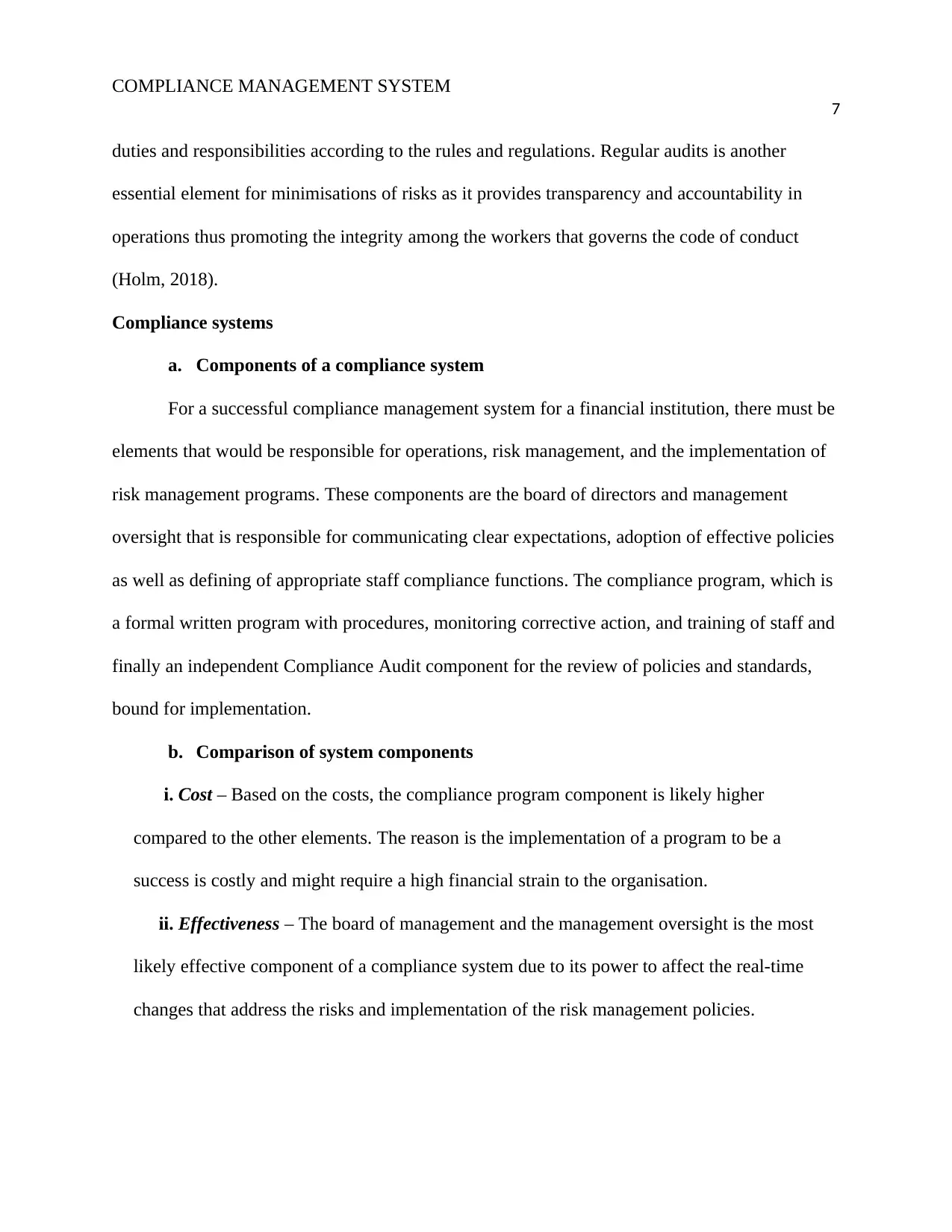
COMPLIANCE MANAGEMENT SYSTEM
7
duties and responsibilities according to the rules and regulations. Regular audits is another
essential element for minimisations of risks as it provides transparency and accountability in
operations thus promoting the integrity among the workers that governs the code of conduct
(Holm, 2018).
Compliance systems
a. Components of a compliance system
For a successful compliance management system for a financial institution, there must be
elements that would be responsible for operations, risk management, and the implementation of
risk management programs. These components are the board of directors and management
oversight that is responsible for communicating clear expectations, adoption of effective policies
as well as defining of appropriate staff compliance functions. The compliance program, which is
a formal written program with procedures, monitoring corrective action, and training of staff and
finally an independent Compliance Audit component for the review of policies and standards,
bound for implementation.
b. Comparison of system components
i. Cost – Based on the costs, the compliance program component is likely higher
compared to the other elements. The reason is the implementation of a program to be a
success is costly and might require a high financial strain to the organisation.
ii. Effectiveness – The board of management and the management oversight is the most
likely effective component of a compliance system due to its power to affect the real-time
changes that address the risks and implementation of the risk management policies.
7
duties and responsibilities according to the rules and regulations. Regular audits is another
essential element for minimisations of risks as it provides transparency and accountability in
operations thus promoting the integrity among the workers that governs the code of conduct
(Holm, 2018).
Compliance systems
a. Components of a compliance system
For a successful compliance management system for a financial institution, there must be
elements that would be responsible for operations, risk management, and the implementation of
risk management programs. These components are the board of directors and management
oversight that is responsible for communicating clear expectations, adoption of effective policies
as well as defining of appropriate staff compliance functions. The compliance program, which is
a formal written program with procedures, monitoring corrective action, and training of staff and
finally an independent Compliance Audit component for the review of policies and standards,
bound for implementation.
b. Comparison of system components
i. Cost – Based on the costs, the compliance program component is likely higher
compared to the other elements. The reason is the implementation of a program to be a
success is costly and might require a high financial strain to the organisation.
ii. Effectiveness – The board of management and the management oversight is the most
likely effective component of a compliance system due to its power to affect the real-time
changes that address the risks and implementation of the risk management policies.
Paraphrase This Document
Need a fresh take? Get an instant paraphrase of this document with our AI Paraphraser
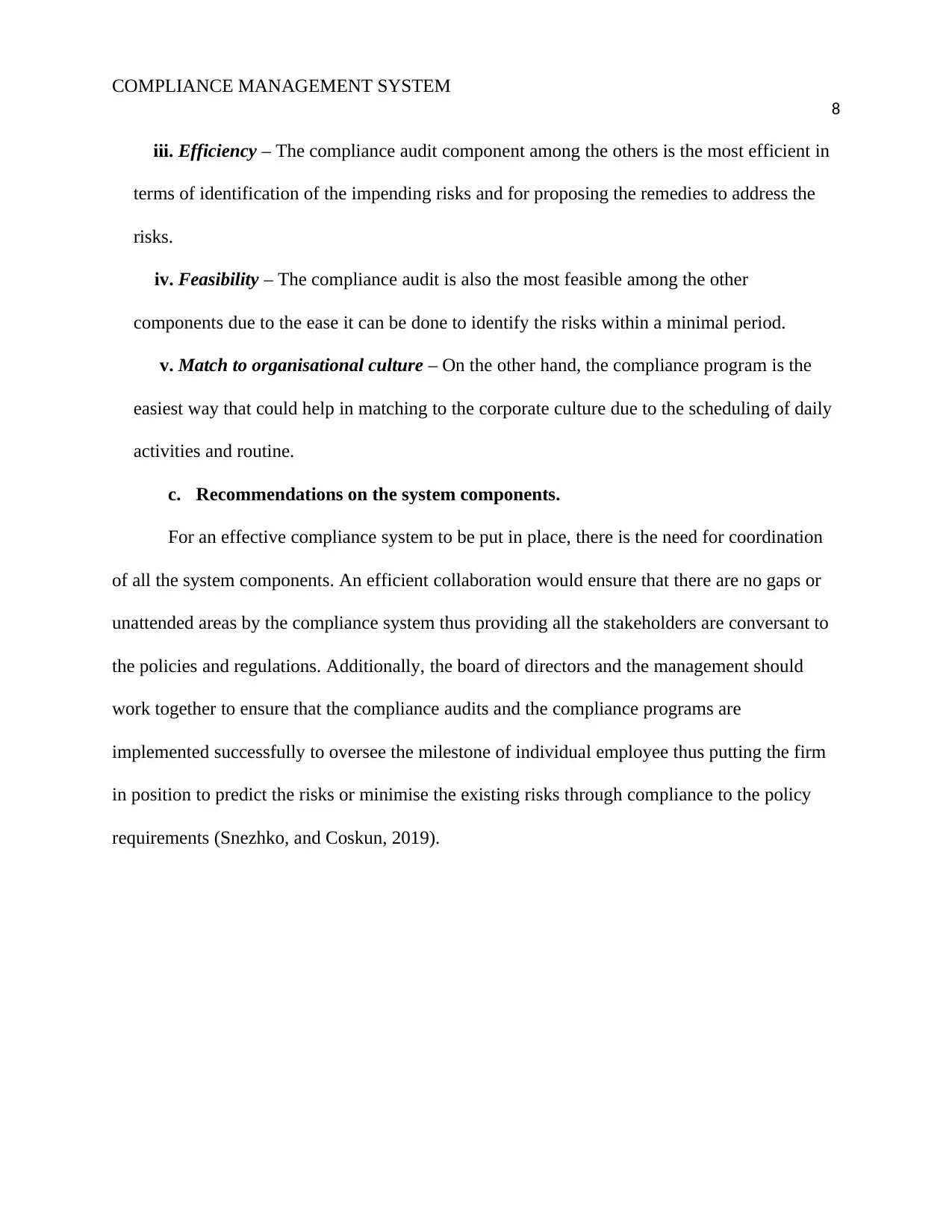
COMPLIANCE MANAGEMENT SYSTEM
8
iii. Efficiency – The compliance audit component among the others is the most efficient in
terms of identification of the impending risks and for proposing the remedies to address the
risks.
iv. Feasibility – The compliance audit is also the most feasible among the other
components due to the ease it can be done to identify the risks within a minimal period.
v. Match to organisational culture – On the other hand, the compliance program is the
easiest way that could help in matching to the corporate culture due to the scheduling of daily
activities and routine.
c. Recommendations on the system components.
For an effective compliance system to be put in place, there is the need for coordination
of all the system components. An efficient collaboration would ensure that there are no gaps or
unattended areas by the compliance system thus providing all the stakeholders are conversant to
the policies and regulations. Additionally, the board of directors and the management should
work together to ensure that the compliance audits and the compliance programs are
implemented successfully to oversee the milestone of individual employee thus putting the firm
in position to predict the risks or minimise the existing risks through compliance to the policy
requirements (Snezhko, and Coskun, 2019).
8
iii. Efficiency – The compliance audit component among the others is the most efficient in
terms of identification of the impending risks and for proposing the remedies to address the
risks.
iv. Feasibility – The compliance audit is also the most feasible among the other
components due to the ease it can be done to identify the risks within a minimal period.
v. Match to organisational culture – On the other hand, the compliance program is the
easiest way that could help in matching to the corporate culture due to the scheduling of daily
activities and routine.
c. Recommendations on the system components.
For an effective compliance system to be put in place, there is the need for coordination
of all the system components. An efficient collaboration would ensure that there are no gaps or
unattended areas by the compliance system thus providing all the stakeholders are conversant to
the policies and regulations. Additionally, the board of directors and the management should
work together to ensure that the compliance audits and the compliance programs are
implemented successfully to oversee the milestone of individual employee thus putting the firm
in position to predict the risks or minimise the existing risks through compliance to the policy
requirements (Snezhko, and Coskun, 2019).
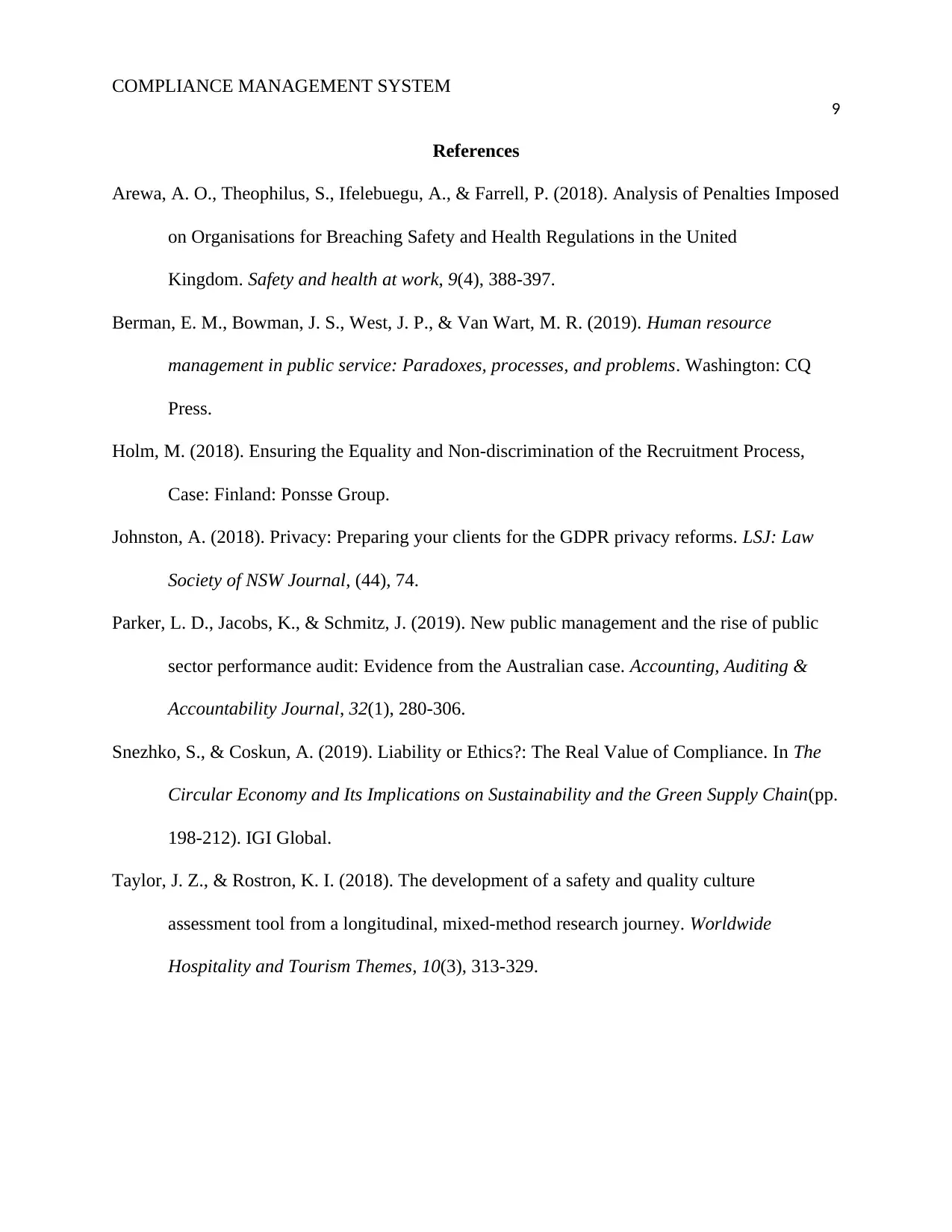
COMPLIANCE MANAGEMENT SYSTEM
9
References
Arewa, A. O., Theophilus, S., Ifelebuegu, A., & Farrell, P. (2018). Analysis of Penalties Imposed
on Organisations for Breaching Safety and Health Regulations in the United
Kingdom. Safety and health at work, 9(4), 388-397.
Berman, E. M., Bowman, J. S., West, J. P., & Van Wart, M. R. (2019). Human resource
management in public service: Paradoxes, processes, and problems. Washington: CQ
Press.
Holm, M. (2018). Ensuring the Equality and Non-discrimination of the Recruitment Process,
Case: Finland: Ponsse Group.
Johnston, A. (2018). Privacy: Preparing your clients for the GDPR privacy reforms. LSJ: Law
Society of NSW Journal, (44), 74.
Parker, L. D., Jacobs, K., & Schmitz, J. (2019). New public management and the rise of public
sector performance audit: Evidence from the Australian case. Accounting, Auditing &
Accountability Journal, 32(1), 280-306.
Snezhko, S., & Coskun, A. (2019). Liability or Ethics?: The Real Value of Compliance. In The
Circular Economy and Its Implications on Sustainability and the Green Supply Chain(pp.
198-212). IGI Global.
Taylor, J. Z., & Rostron, K. I. (2018). The development of a safety and quality culture
assessment tool from a longitudinal, mixed-method research journey. Worldwide
Hospitality and Tourism Themes, 10(3), 313-329.
9
References
Arewa, A. O., Theophilus, S., Ifelebuegu, A., & Farrell, P. (2018). Analysis of Penalties Imposed
on Organisations for Breaching Safety and Health Regulations in the United
Kingdom. Safety and health at work, 9(4), 388-397.
Berman, E. M., Bowman, J. S., West, J. P., & Van Wart, M. R. (2019). Human resource
management in public service: Paradoxes, processes, and problems. Washington: CQ
Press.
Holm, M. (2018). Ensuring the Equality and Non-discrimination of the Recruitment Process,
Case: Finland: Ponsse Group.
Johnston, A. (2018). Privacy: Preparing your clients for the GDPR privacy reforms. LSJ: Law
Society of NSW Journal, (44), 74.
Parker, L. D., Jacobs, K., & Schmitz, J. (2019). New public management and the rise of public
sector performance audit: Evidence from the Australian case. Accounting, Auditing &
Accountability Journal, 32(1), 280-306.
Snezhko, S., & Coskun, A. (2019). Liability or Ethics?: The Real Value of Compliance. In The
Circular Economy and Its Implications on Sustainability and the Green Supply Chain(pp.
198-212). IGI Global.
Taylor, J. Z., & Rostron, K. I. (2018). The development of a safety and quality culture
assessment tool from a longitudinal, mixed-method research journey. Worldwide
Hospitality and Tourism Themes, 10(3), 313-329.
⊘ This is a preview!⊘
Do you want full access?
Subscribe today to unlock all pages.

Trusted by 1+ million students worldwide
1 out of 9
Related Documents
Your All-in-One AI-Powered Toolkit for Academic Success.
+13062052269
info@desklib.com
Available 24*7 on WhatsApp / Email
![[object Object]](/_next/static/media/star-bottom.7253800d.svg)
Unlock your academic potential
Copyright © 2020–2025 A2Z Services. All Rights Reserved. Developed and managed by ZUCOL.





